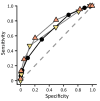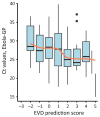Rapid Decision Algorithm for Patient Triage during Ebola Outbreaks
- PMID: 39447210
- PMCID: PMC11521189
- DOI: 10.3201/eid3011.231650
Rapid Decision Algorithm for Patient Triage during Ebola Outbreaks
Abstract
The low specificity of Ebola virus disease clinical signs increases the risk for nosocomial transmission to patients and healthcare workers during outbreaks. Reducing this risk requires identifying patients with a high likelihood of Ebola virus infection. Analyses of retrospective data from patients suspected of having Ebola virus infection identified 13 strong predictors and time from disease onset as constituents of a prediction score for Ebola virus disease. We also noted 4 highly predictive variables that could distinguish patients at high risk for infection, independent of their scores. External validation of this algorithm on retrospective data revealed the probability of infection continuously increased with the score.
Keywords: Algorithm; Democratic Republic of the Congo; Ebola; clinical signs; contact; epidemics; exposure; outbreaks; predictors; symptomatology; symptoms; triage.
Figures





References
-
- World Health Organization. Case definition recommendations for Ebola or Marburg virus diseases. 2014. [cited 2024 Jun 8]. https://iris.who.int/bitstream/handle/10665/146397/WHO_EVD_CaseDef_14.1_...
MeSH terms
LinkOut - more resources
Full Text Sources
Medical

